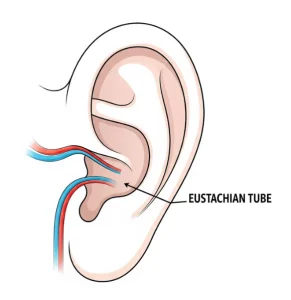Why do your ears pop while you’re in a hyperbaric chamber?
You might have felt the pressure or “popping” feeling in your ears if you’ve ever been on an aircraft or driven through the mountains. It can also happen in a hyperbaric oxygen chamber, and that’s okay. You will need to equalize your ears to release that pressure.
Changes in pressure cause that feeling. As the chamber fills with air, the air inside gets heavier. Your body adapts, but your middle ear (the region beneath your eardrum) needs a little help to catch up.
The Eustachian tube is a tiny tube that links your middle ear to the back of your nose and throat. It works like a valve that lets pressure out, which helps equalize your ears and stay in harmony with the world around you.
If your Eustachian tubes stay closed when the pressure goes up, you could feel:
- A feeling of fullness or blockage in your ears
- Hearing that is muffled
- A little bit of pain or pressure
That’s when you need to equalize your ears.

What Does ”Equalizing Your Ears” Mean?
Equalizing is when you open your Eustachian tubes so that air can flow into your middle ear and equalize the pressure inside your ear with the pressure in the chamber. This releases some of the pressure and helps you stay comfortable during your session.
It’s easy to accomplish, and with a little practice, it becomes second nature!
5 Simple Ways to Equalize Your Ears
Here are four simple things you can do to equalize your ears while in a hyperbaric chamber:
1. Swallowing – When you swallow, the muscles that open your Eustachian tubes get going. Try drinking water or carefully swallowing your saliva.
2. Yawning – A huge yawn, or even a fake one, can help your ear canals expand. Start yawning periodically as the pressure increases; this is the best way to keep the pressure from building up.
3. Chew a piece of Gum – Chewing gum keeps Eustachian tubes open..
4. The Valsalva Move – This is a fancy name for a simple move:
- Use your fingers to pinch your nose shut.
- Shut your mouth
- Try to blow air out of your nose slowly.
You should feel a tiny ”pop” or release of pressure in your ears. Don’t blow too hard; just enough to feel it move and ”equalize” the pressure.
5. The Toynbee Move – Doing this requires two simple moves at once:
- Hold your nose
- At the same moment, swallow.
It works quite well for a lot of folks, but it may require some practice.
Tip: Start equalizing early in the pressurization process and do it often. Don’t wait until your ears hurt.
If you still can’t equalize, then what?
Don’t worry; this happens a lot, especially to people who are just starting off.
What you need to do is:
Slow down the pressurization: Our hyperbaric chambers let you stop or lower the pressurization from inside the chamber or a or a technician can adjust the controls from outside the chamber, so you can get to a comfortable level.
Don’t push through discomfort; it’s a cue to halt and make changes, not something to disregard.
Once comfortable, you can try to increase the pressure to get to the depth that you want. Please note that every person and ”dive” or session is different. Because you’ve been to 2.0 ATAs in previous sessions, it does not mean that it will always be that way.
Listen to your body and make the adjustments necessary to stay comfortable and safe.
Why It Matters
If you want to get the most out of your hyperbaric oxygen treatment (HBOT) session, you need to keep your ears balanced. Discomfort can be distracting, and if you don’t take care of it, it could cause transient ear barotrauma, which is moderate ear discomfort or pressure injury.
But when done appropriately, HBOT helps with:
- Getting well and healing after an injury or surgery
- Less inflammation and long-term pain
- Better supply of oxygen for energy and focus
- Support for the brain and nervous system
- How the immune system works
The Cleveland Clinic and Johns Hopkins Medicine have published medical articles on the anatomy of the ear and how the eustachian tube works.
Interested in Learning More?
If you’re ready to take your health, recovery, and performance to the next level, exploring hyperbaric chambers for sale is a great place to start.
Hyperbaric oxygen therapy (HBOT) works by increasing the amount of oxygen your body can absorb, helping tissues repair faster, reducing inflammation, and boosting overall vitality. Whether you’re an athlete recovering from intense training, someone healing after surgery, or simply looking to age gracefully, HBOT offers powerful, drug-free support.
Browse our blog to find information about what conditions HBOT can treat and see if Hyperbaric therapy may help you live a healthier, more active, and comfortable life.
At Hyperbaric Health, we offer a range of hard-shell and soft-shell hyperbaric chambers built for home and clinical use—with features like seated comfort, customizable finishes, built-in red light therapy, and advanced safety systems.
To explore our full range and find the chamber that’s right for you, visit Hyperbaric Health’s Hyperbaric Chambers for Sale page.


